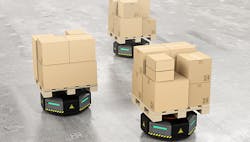Autonomous mobile robots (AMRs) can seem like self-driving cars—we know the technology exists, but is it ready for the real world? In the next few years, especially as e-commerce continues to accelerate at a rapid pace and consumers demand more and faster, companies will need to innovate to meet demand in creative ways. The good news is AMR technology is ready for real-world use and can provide the answer.
This emerging technology, though, is hardly one-size-fits-all. Instead, companies should carefully consider growth trajectory, in-house capabilities and potential applications before committing to AMRs. A good plan is essential for a great experience with any technology, new or old.
Defining AMRs
AMRs are industrial robots that lift and transport materials—larger versions lift and move pallets of product, smaller versions lift and move cartons or totes, and they can be configured to carry multiple totes or inventory carts. They navigate themselves around a facility by reading QR codes and sensing obstacles they encounter, taking loads from Point A to Point B. Fast deployment is one of their key advantages.
While AMRs aren’t an altogether new technology—they’ve been used in logistics for a decade — they’re attracting more attention as companies seek new ways to optimize their operations in an instant-gratification environment and as the artificial-intelligence (AI) capabilities within solutions like AMRs advance.
AMRs come with more than a few perks. One of the biggest is flexible routing capabilities. Many AMRs can reroute themselves when encountering an obstacle, which increases their productivity. Previous generations of technology could only wait for an obstacle to be removed. AMRs are flexible, allowing users to make quick path adjustments during operation, and they’re dependable, operating 24/7 if needed. AMRs can increase fulfillment speeds and improve efficiency as a new system or as one retrofitted to work within an existing operation. AMRs are being used to replace fixed path solutions such as pallet conveyor, which often forms inflexible border walls inside facilities.
Consider your growth trajectory
In today’s environment, labor shortages and high demand can drive a business to throw every automation solution at the metaphorical wall to see what sticks. AMRs, even with their myriad benefits, might not be the best option for every situation.
Companies with a predictable growth path that have only modest seasonal variations are ideal deployments for AMRs. Similar and consistent growing volumes allow deployments to be tuned to just the right quantity of AMRs, and year-round activity ensures that capital is not underutilized.
Companies with large seasonal spikes may encounter unanticipated challenges with congestion at peak, which could prove problematic unless simulated thoroughly. During off-peak times, the risk of underutilized capital could impact the real return on their investment.
Consider your capabilities
Automation of any type requires some level of support. AMRs are no different. It’s easy to forget about who is going to provide this support as you are considering an exciting new technology. If you don’t have resources in-house, make sure your provider has a robust support network of both parts and technicians who can keep your investment running well. Information-technology resources can also be tough to come by in many companies. AMR control software is very stable and doesn’t require a lot of internal support, but every deployment does interact with a number of systems. Make sure you talk with your team about the interfaces for an AMR system and who is going to support them.
The road ahead
AMRs are going to continue to make inroads into traditional warehouse applications. It’s hard to predict exactly when the hockey-stick curve will appear, but it’s not far off. One of the factors that will drive that coming surge is increasingly sophisticated guidance systems. Many AMRs now are limited by relatively basic guidance systems. These AMRs currently navigate by QR codes placed on the floor and have limited sensing abilities. This means that, for high-rate systems, they must be kept separate from pedestrians for safety and throughput reasons. However, simultaneous localization and mapping (SLAM)—an algorithm allowing autonomous robots or vehicles to map out unknown environments—will change the game.
With SLAM, retailers could implement AMRs in mixed model environments. Consider a retail location where you are either shopping in-store or picking up items you selected online. When you make a purchase, an AMR retrieves the item from the micro-fulfillment center at the back of the store and delivers the item directly to you. The entire sale is facilitated in-store.
Even if you decide AMRs aren’t the right fit for your business, keep an eye on the space as AMRs become more commonly used. AMRs are in the process of going from leading-edge curiosity to indispensable supply-chain system. Twenty-five years ago, many thought of cell phones as a curiosity. Today, most people don’t even have a land line. In the not-too-distant future, you are going to wonder how you managed fulfillment operations without AMRs.
Bill Boer is director of solution consulting at Dematic. Contact him at [email protected].
About the Author
Bill Boer
Dematic

Leaders relevant to this article:

